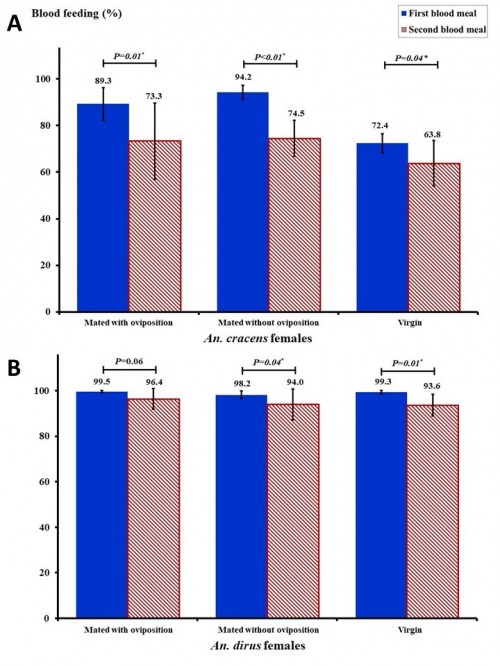Vol. 6, Issue 6, Part A (2019)
Comparison of Anopheles cracens (Stenogamous) and Anopheles dirus (Eurygamous) blood-feeding behaviors, survival rates and fecundity after first and second blood meals
Author(s): Siriporn Phasomkusolsil, Orawan Wongnet, Kanchana Pantuwatana, Jaruwan Tawong, Nantaporn Monkanna, Tanaporn Kornkan, Silas A Davidson, Betty K Poole-Smith and Patrick W Mccardle
Abstract: Malaria is a serious health problem in Southeast Asia. The malaria vectors Anopheles cracens (Stenogamous) and Anopheles dirus (Eurygamous) were used to evaluate the impact of first and second blood meals on feeding, survival and hatching rates, and fecundity. Females were divided as follows: mated with oviposition, mated without oviposition, and virgin. The blood-feeding rates of An. cracens groups were significantly lower for the second blood meal than for the first. Additionally, for An. dirus mated without oviposition and virgin groups, blood-feeding rates were significantly lower for the second blood meal compared with the first blood meal. Survivorship and the number of eggs laid increased for An. cracens after the second blood meal, but the opposite was true for An. dirus. There were no differences in hatching rates. Thus, blood meals affected survivorship and fecundity in naturally mating An. cracens and induced-mating An. dirus.

Fig.: Mean percentage first and second blood-feedings of mated females with oviposition, mated females without oviposition and virgin females of An. cracens (A) and An. dirus (B). After the first blood meal and investigation of the female survival rates per cage, a second blood meal was offered. *Significant P-values in each row between first and second blood meals as assessed by t-tests (P< 0.05). Bars depict means, and error bars indicate standard deviations. (Y axis=blood-feeding %; X axis=establishing groups).
Pages: 14-21 | 1294 Views 132 Downloads
How to cite this article:
Siriporn Phasomkusolsil, Orawan Wongnet, Kanchana Pantuwatana, Jaruwan Tawong, Nantaporn Monkanna, Tanaporn Kornkan, Silas A Davidson, Betty K Poole-Smith, Patrick W Mccardle. Comparison of Anopheles cracens (Stenogamous) and Anopheles dirus (Eurygamous) blood-feeding behaviors, survival rates and fecundity after first and second blood meals. Int J Mosq Res 2019;6(6):14-21.







